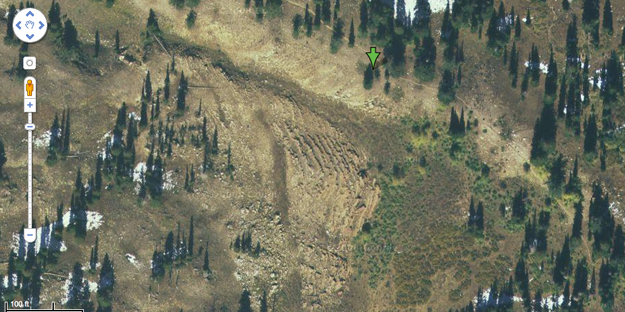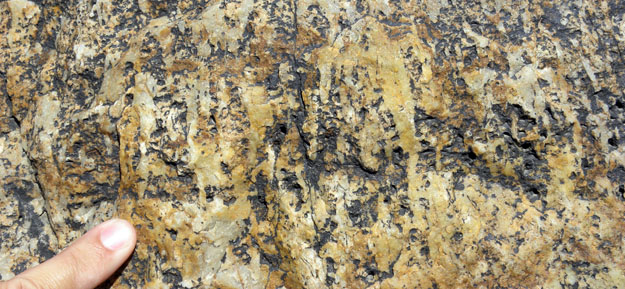LOGAN, UTAH–Today we hiked north of Tony Grove Lake in Logan Canyon to explore an Ordovician sequence of rocks. The most interesting unit (to my surprise) was the Swan Peak Quartzite, an orange-brown unit at the base of a white dolomite and gray limestone. It weathers in sharp edges and large blocks tumbled down the slopes. Quartzite began as a quartzose sandstone which was metamorphosed into a rock where the silica cement is as hard as the quartz grains. Most fossils are destroyed in this metamorphosis, along with almost all sedimentary features, so I didn’t expect to see much in the Swan Peak.

Outcrop of the Swan Peak Quartzite (Ordovician) north of Tony Grove Lake, Utah. This photograph was taken facing north at N41° 54.198′, W 111° 38.72′.

Google Earth image of the Swan Peak Quartzite exposure. The green arrow is the location from where the outcrop photograph above was taken. The stepped nature of the rocks is easily visible in the middle of the image.
The Swan Peak Quartzite is exposed here as a series of large steps looking something like a side of an eroded Egyptian pyramid. Why does it erode into this kind of stairway instead of one large block? A close examination of the rock surfaces revealed trace fossils were preserved — the kind of fossils which could be clues to the character of this formation.

Horizontal burrow systems preserved in remnant bedding planes of the Swan Peak Quartzite. These traces give the rock its local name of “Fucoidal Quartzite”. Fucoidal is an old word for trace fossils.
It appears that the step surfaces have horizontal burrow systems, and the “risers” have vertical burrows (Skolithos). There is an alternation of beds with horizontal burrows and beds with vertical burrows through the Swan Peak Quartzite. The horizontally-burrowed units are less resistant than the vertically-burrowed units, so this alternation produces the stepped erosion pattern.
My hypothesis is that the horizontal burrows represent slightly deeper water than the vertical burrows, based on the distribution to such burrow systems in other formations and in today’s oceans. The alternation between the two trace fossil types may thus show fluctuating sea levels as the Swan Peak sediments were deposited way back in the Ordovician.
So, this unpromising rock may indeed be providing clues to its ancient depositional environment through the trace fossils it contains.
[Author’s note (July 27, 2020): Dave Powelson kindly pointed out to me that the Swan Peak Quartzite is not actually a metamorphic quartzite but a silica-cemented orthoquartzite sedimentary rock. I should have called it by its more neutral name, the Swan Peak Formation. This solves the mystery of why the trace fossils are so well preserved. Thanks, Dave!]



